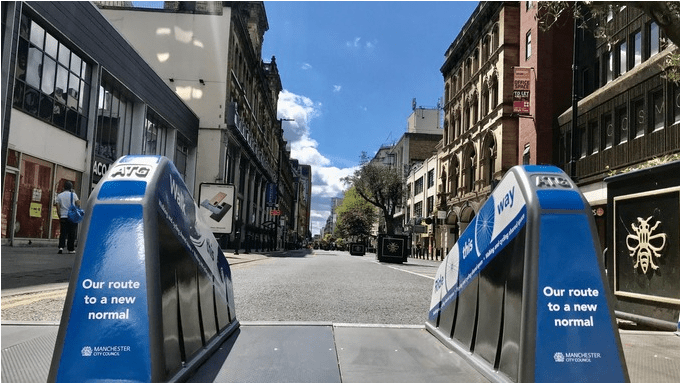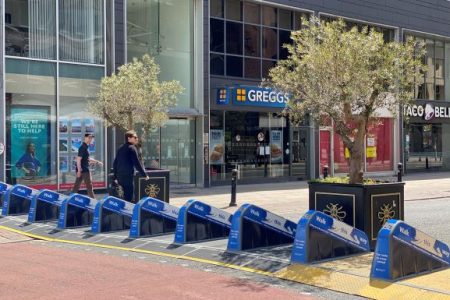There is speculation all across the country as to which of the habits and trends popularised over lockdown will go on to influence our lifestyles for the longer term. From remote working to the impact on education to the future of our towns and city centres, so much remains unknown. One trend that has prompted much discussion – and no small amount of controversy – is that of the pedestrianisation of city streets.
Pedestrianised zones have been on the rise for some time, as we’ve adopted a more European-style approach to outdoor dining and leisurely strolls. The pandemic has accelerated the trend, however, with public health concerns and environmental benefits such as reduced air pollution driving interest in pedestrianisation of urban locations.
UK cities including London, Birmingham, Bath and Manchester have introduced widespread measures for tackling air pollution in response to public health warnings. Worldwide, air pollution is a significant threat to health and life, with ambient air pollution a recognised cause of roughly 4.2 million premature deaths each year, according to the WHO. It is a contributor to strokes, heart disease, pulmonary diseases, cancers and respiratory infections. Poor air quality also stunts the growth of children’s lungs and worsens chronic illness such as asthma.
Pedestrianisation of urban spaces plays a central role within the Government’s strategies to tackle air pollution here in the UK, because of its potential to greatly reduce vehicle emissions and noise pollution. In addition to making it easier and safer to walk or cycle through the city, widening footpaths and creating new cycle lanes also forms part of a wider scheme to orient urban spaces away from cars and towards pedestrians, cyclists and mass transit.
With economic recovery now firmly in our sights, some cities are also keen to explore how pedestrianisation may positively impact footfall and business revenue in urban areas.
In the past, transforming areas into pedestrian-friendly zones has often lead to a good return on investment, especially for retailers. In fact, research from High Streets Task Force suggests that quantifiable returns can be made by improving pedestrian and cyclist access, as they point to one case study wherein a £10 million investment made in Piccadilly, Stoke-on-Trent, led to a 30% increase in footfall in the area. Such improvements that increase footfall can be seen to directly lead to increased retail sales.
The hospitality sector – one of those hit hardest by the pandemic – could benefit significantly from pedestrianisation, with the potential for outdoor dining as the warmer weather arrives. Along with the lobby to repeat the ‘Eat Out to Help Out’ scheme, enabling the capacity for customers to return to hospitality businesses as soon as Easter in an outdoor environment where infection is less likely, could be a welcome boon to bars and restaurants.
Many hospitality businesses have already ploughed significant investment into outdoor dining equipment and social distancing and sanitisation measures. The movement proved immensely popular and there are indications that outdoor dining – already hugely popular in metropolises like New York City – is not just a way of allowing businesses to operate or customers to feel safer, but a lifestyle trend that will remain long after the virus has abated.
Once lockdowns are eased and the normal pace of life begins to return, so too will tourism. Many city planners are speculating about the allure of pedestrianised public places, flanked with colourful shops and cafes, and the contribution this will make in attracting tourists to the local area in future.
However, pedestrianisation is not popular with everyone. Those opposed to pedestrianisation say that it causes disruption to deliveries, makes accessibility a challenge for blue-badge holders and can stop people shopping locally. Careful consideration regarding the location of pedestrianised zones is needed therefore, along with the potential to enable vehicular access at restricted times of day or for emergency vehicles.
There is a balancing act to be achieved by addressing the challenges of public health, social inequality and climate and ecological emergencies on the one hand, while being mindful of the practical needs of city dwellers and small business owners on the other.

Keeping pedestrianised areas safe
Establishing a pedestrianised area in a town or city can be accomplished quickly – Crowdguard’s ATG Surface Guard barrier system can be installed in as little as 30 minutes. Planning for pedestrianisation must be a thorough process, however, with extensive consideration of points including emergency vehicle access, vehicle diversions and more.
Full-time, part-time or temporary pedestrianisation of city streets are all potential options, But it is important to remember that, no matter the length of time the area is pedestrianised, the safety of those using pedestrianised zones is vital.
Sadly, pedestrianised areas can become the target of would-be vehicle-as-a-weapon (VAW) attackers, who seize on the vulnerability of individuals in a crowded space and can exploit flimsy, incomplete or missing barriers in order to cause damage to property, injury or worse.
In order to demonstrate due diligence, planners must implement rigorously tested solutions which mitigate threats to public safety in these environments. Many city planners are now opting for pedestrian permeable barriers, which allow walkers, cyclists, prams and wheelchairs to pass through with ease, but guard against the ingress of a hostile vehicle.
As the number of tragic VAW incidents has grown over the past five years, so too has public awareness around the issue. Nervousness that a public space will be targeted in an attack can have an adverse impact on consumer confidence, causing people to think twice about frequenting vulnerable public spaces for fear of terrorist threats.
In a post-COVID landscape, those hoping to attract individuals back to the city centre for work and leisure will be faced with the task of raising public confidence and demonstrating that the area is ready to welcome consumers and diners to city-centre businesses once again. Crowd safety measures that aid and support social distancing and protect pedestrians from the threat of VAW attacks must also be visually appealing, therefore, and give a feeling of openness so that citygoers do not feel penned in.
Crowdguard has partnered with numerous city planners and local authorities to establish temporary and semi-permanent pedestrianised spaces that support social distancing during the COVID-19 pandemic, and we will continue to aid the development of safe pedestrianised spaces in 2021. Our award-winning pedestrian permeable barrier is modular, lightweight and easily stacked and moved, enabling quick and efficient deployment with no need for heavy machinery.
At Crowdguard we are committed to supporting city planners as they shape the city centre spaces of tomorrow. If you would like to know more about Crowdguard’s innovative offering, contact 0161 507 3434 today.
To stay up to date on the latest, trends, innovations, people news and company updates within the global security market please register to receive our newsletter here.
Media contact
Rebecca Morpeth Spayne,
Editor, Security Portfolio
Tel: +44 (0) 1622 823 922
Email: editor@securitybuyer.com













